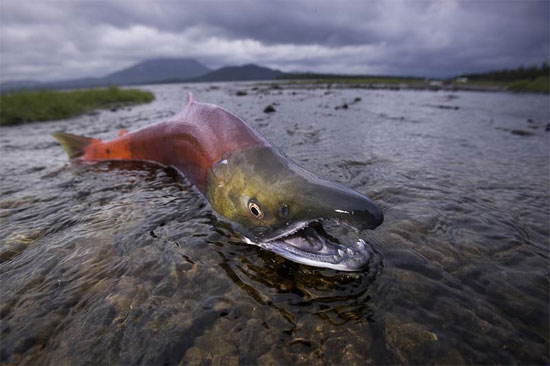Salmon and mysterious breeding mechanism against
Scientists at the University of East Anglia (UEA) in the UK are looking for a solution to the mysterious selection mechanism, avoiding the risk of 'mistaken' fertilization that female salmon use.
Scientists studied two salmon and trout species. As an external fertilization species, they sometimes crossbred in the wild but the offspring are not fertile. Children of both species must choose to avoid mistaken sperm fertilization of other species.
Research shows that when the eggs of each species are born, they can fertilize another species. However, if the egg has both sperms to choose from, they will choose the same sperm.

Photo: amazon.com
Lead researcher Professor Matt Gage, of UEA, said: "Because we conducted in vitro fertilization, there was no intervention or control from males or females so this is clear evidence that If selected, the egg will select sperm of the same species ".
To explain this, scientists analyzed sperm in the ovaries. As a result, they found that the ovaries delivered chemical signals to sperm of the same species and 'guided' sperm to the correct position of fertilization.
To prove that this is the mechanism that helps fish to fertilize sperm properly , the team conducted the final test. They move the sperm through a small pore-permeable membrane that simulates the only way into the egg. They found that in the ovaries and sperm-rich species swim through the membrane more than the number of sperm swimming through the membrane in the ovary of another species.
Professor Gates concluded: "These findings allow us to confirm, indeed, that salmon have developed 'mysterious choice' mechanisms to identify sperm of the same species. explaining why mating females are usually fertilized by 8, even 16 males, by promoting competition for sperm, more selective eggs, ovaries help to avoid breeding and prioritize sperm of the same species ".
The study was funded by the British Council for Natural Environmental Research (NERC) and cooperation between UEA, Norwegian Natural Research Institute and Zoological Institute (UK).
Research results have been published in Evolution magazine.
- Video: Testing compressed air cannon to bring salmon to breeding ground
- Severe drought, the US carries 30 million salmon to the sea
- Detect 3 mysterious viruses that have not been detected in Pacific salmon species
- Animals are capable of causing the Earth to shake when it is done.
- Spectacular migration of red salmon in Canada
- The ancestors of salmon have sharp teeth 20cm long
- Russia implemented a salmon protection project for future generations
- This is why you should stop eating farmed salmon
- Can catch giant salmon, like monsters in America
- Natural mystery: migrate a record 8 million salmon
- Strange salmon flock across the road right in front of the car
- Video: Giant salmon stalking rats
 Surprised: Fish that live in the dark ocean still see colors
Surprised: Fish that live in the dark ocean still see colors Japan suddenly caught the creature that caused the earthquake in the legend
Japan suddenly caught the creature that caused the earthquake in the legend A series of gray whale carcasses washed ashore on California's coast
A series of gray whale carcasses washed ashore on California's coast Compare the size of shark species in the world
Compare the size of shark species in the world